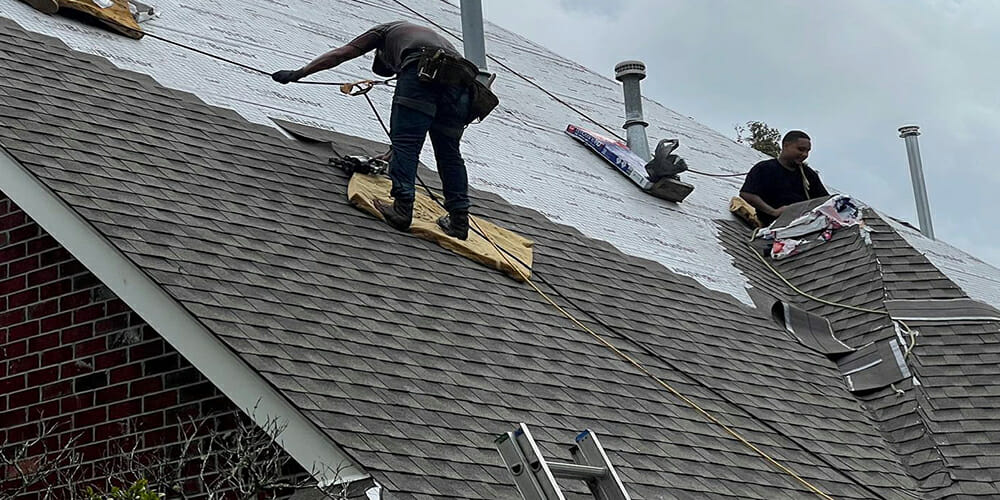Seasonal Roofing System Fixing Checklist: Prepare Your Roof for Every Weather
By following a seasonal roof fixing checklist, you can stay in advance of prospective issues. Allow's discover just how correct upkeep can safeguard your home and extend your roof covering's life expectancy.
Examining Your Roofing for Winter Readiness
As winter months techniques, it's necessary to check your roofing to validate it can stand up to rough climate condition. Start by examining for missing out on or harmed tiles; even a small issue can cause substantial leaks when snow and ice collect. Next, check out the flashing around smokeshafts and vents-- this location is typically susceptible to water invasion.
Do not forget to look for signs of drooping or uneven surfaces, as these could indicate architectural problems. In addition, confirm your gutters are clear; clogged seamless gutters can lead to ice dams that harm your roof.
 roof repair
roof repair
Spring Cleansing: Cleaning Particles and Checking for Damages
Once winter season's grasp launches, it's time to tackle springtime cleaning on your roof by eliminating debris and inspecting for any damages. Begin by inspecting your roofing system for fallen branches, leaves, and various other particles that can trap wetness and cause rot. A tidy roof covering advertises better drain and prevents mold and mildew growth.
Next, grab a tough ladder and very carefully check shingles for fractures or missing out on pieces. Pay interest to locations around chimneys and vents, as these spots are vulnerable to leakages. Don't fail to remember to examine your rain gutters, ensuring they're devoid of obstructions that might bring about water pooling.
While you're up there, look for signs of wear, like rust on steel blinking or loosened seals around skylights. Addressing them now can save you from costly repair services later on if you spot any kind of problems. A little spring cleansing goes a long way in maintaining your roofing's stability.
Summertime Heat: Examining Your Roof for Heat-Related Issues
As summer season warm increases, it's necessary to examine your roofing system for heat-related issues. Inspect for any kind of shingle damage, try to find indicators of warmth buckling, and review just how well your roofing aerates. Taking these steps now can avoid bigger problems in the future.
Check for Tile Damage
 roof repair
roof repair
Look For Heat Buckling
Warmth buckling is an usual problem that can emerge during the scorching summertime, and it's essential to inspect for it on your roofing. As temperatures skyrocket, roof covering materials, particularly asphalt roof shingles, can expand and contract. This motion can result in warping, producing unpleasant lumps or splits. Begin by examining your roof aesthetically; look for any type of uneven surfaces or lifted sides. Pay special attention to locations around vents and chimneys, where fastening is more probable to happen. If you spot any indicators of heat buckling, it's essential to address them immediately to stop further damage. If you're not sure concerning the degree of the issue or how to repair it effectively., consider speaking with a professional.
Review Roof Ventilation Effectiveness
After inspecting for warmth buckling, it is necessary to examine your roof's ventilation effectiveness. Correct air flow aids manage temperature and wetness, protecting against damage from too much warmth. Beginning by examining your vents; make certain they're not blocked by particles or insulation. Seek indicators of poor airflow, like warm buildup in your attic room or deformed roofing products. You may additionally desire to examine if your soffit vents and ridge vents collaborate successfully. If your home feels stale and overheated, think about updating to much more reliable air flow systems, like powered attic fans or extra soffit vents. Bear in mind, maintaining excellent ventilation not only extends your roof covering's life but additionally enhances your home's overall energy effectiveness, ensuring comfort throughout those warm summertime.
Rainy Period Readiness: Ensuring Appropriate Water Drainage
As the stormy season strategies, you require to assure your roofing system's drain system is prepared to handle heavy rainstorms. Start by checking your rain gutters and downspouts, and make sure they're clear of particles. Do not forget to examine the flashing and seals to stop leaks and water damage.
Inspect Rain Gutters and Downspouts
Beginning by examining for any noticeable debris, like branches or fallen leaves, that could block the flow of water. Next, examine the downspouts for blockages or damage; an obstructed downspout can create water to overflow, potentially destructive your roofing system and foundation. If you spot any type of concerns, address them without delay to stop costly repairs.
Clean Roof Surface Debris
To ensure your roofing system can deal with the wet period, it's important to cleanse any particles from the surface area consistently. Leaves, twigs, and dirt can collect, obstructing drain courses and triggering water to swimming pool. This trapped water can result in leaks and damages over time. Get a tough ladder and inspect your roof for any type of accumulation. Utilize a roofing rake or mop to delicately remove particles, being careful not to harm the tiles. Don't neglect to check your seamless gutters also, ensuring they're clear and operating effectively. After cleaning, monitor your roof after heavy rainfalls to detect any kind of possible problems early. Maintaining your roof clear of debris is vital for avoiding costly repairs down the line.
Inspect Flashing and Seals
After clearing your roof of particles, take a closer take a look at the blinking and seals around skylights, vents, and chimneys. These areas are vital for preventing leakages throughout the stormy season. Inspect the blinking for any indicators of rust, cracks, or gaps. If you notice any kind of damages, it is essential to repair or change it immediately. Next, examine the seals; they should be intact and limited. Look for any type of peeling or worn-out locations that could enable water to seep in. If you find any kind of compromised seals, consider resealing them with a top quality roof covering sealant. Ensuring these components are in excellent condition will certainly aid preserve correct drain and safeguard your home from water damages during hefty rainfall.
Checking and Maintaining Roof Seals and Flashing
While it could appear easy to overlook, preserving and checking roof seals and flashing is important for protecting against leakages and water damages. If you detect any type of issues, it's finest to reseal them with proper roof sealer to guarantee a tight fit.
Following, analyze the flashing, which routes water far from crucial locations. Look for rust, loose areas, or curved sides. If you find any kind of damaged blinking, replace it or secure it effectively to keep its integrity. Bear in mind, even a tiny imperfection can cause substantial issues later on.
Lastly, don't neglect to wipe any kind of particles that could obstruct the seals or flashing. Maintaining these components healthy will certainly help protect your roof covering against the elements and expand its lifespan.
Gutter Upkeep: Maintaining Water Streaming Efficiently
Because your rain gutters play a vital role in directing rain away from your home, routine upkeep is vital for stopping water damage and foundation problems. A clogged seamless gutter can lead to water overflow, which might harm your roof and home siding.
If you see any damages, repair or change the affected components immediately. Validate downspouts are routing water at the very least 6 feet away from your foundation.
Lastly, inspect that your gutters are effectively sloped, ideally a quarter inch for each ten feet. This incline assurances water flows smoothly towards the downspouts. Normal maintenance will keep your gutters working effectively and secure your home from pricey repair services.
Setting Up Professional Assessments for Comprehensive Care
Routinely scheduling specialist assessments is necessary for preserving your roof covering's integrity. These experts can spot prospective problems before they turn right into pricey fixings. Objective for at the very least two examinations a year-- one in the springtime and an additional in the loss. This timing permits you to address any damage triggered by winter weather condition or summer season storms.
Throughout examinations, professionals will certainly examine tiles, flashing, and air flow, guaranteeing whatever's in top form. They'll also look for indicators of wear, leakages, or mold, which you might forget. Setting up these examinations not just prolongs your roof's life expectancy yet additionally offers you satisfaction.
If you're unclear regarding the condition of your roof, do not think twice to call a professional. Purchasing these exams currently can conserve you a lot later. Prioritize your roof's health and wellness, and you'll be well-prepared for whatever weather comes your method.
Often Asked Concerns
Just how Usually Should I Inspect My Roofing System Throughout the Year?
You must evaluate your roofing at least two times a year, preferably in spring and autumn. After serious climate events, look for damage too. Routine assessments aid you catch problems early and save cash on fixings.
What Indicators Indicate I Required a Roofing System Substitute Rather of Repair Work?
 roof repair
roof repair
Can I Do Roof Repair Works Myself, or Should I Work with a Specialist?
You can do small roof repair work yourself if you fit with elevations and fundamental devices, but employing an expert guarantees safety and appropriate work. Don't run the risk of damage; it could be worth the financial investment for satisfaction.
What Are the Best Materials for Roofing Repair Works in Various Environments?
For various environments, you'll want products like asphalt shingles for moderate areas, metal roof covering for extremes, and clay tiles for warm areas. Always take into consideration neighborhood weather patterns to guarantee your roofing system endures the aspects effectively.
Just How Do Roof Covering Service Warranties Influence Seasonal Maintenance Responsibilities?
Roof covering guarantees typically specify upkeep duties, so you'll require to examine the terms. If you do not keep your roofing system as called for, you may void the warranty, leaving you responsible for pricey repair services.
Seasonal Roofing Repair Service Checklist: Prepare Your Roof Covering for Every Climate
When winter's hold releases, it's time to take on springtime cleaning on your roofing system by clearing away particles and checking for any kind of damages. Examine for any kind of roof shingles damages, look for indications of heat fastening, and review just how well your roofing system aerates. If you find any type of issues, take into consideration getting in touch with a professional for repair services to maintain your roof covering in top form and protect your home from potential water damages.
While it might seem easy to forget, keeping and inspecting roof covering seals and blinking is important for stopping leaks and water damages.